Dentistry
 A dentist treats a patient with the help of a dental assistant. | |
| Occupation | |
|---|---|
Occupation type | Profession |
Activity sectors | Health care, Anatomy, Physiology, Pathology, Medicine, Pharmacology, Cosmesis, Surgery |
| Description | |
| Competencies |
|
Education required | Dental Degree, Medical Degree |
Fields of employment |
|
Related jobs |
|
| ICD-9-CM | 23-24 |
|---|---|
| MeSH | D003813 |
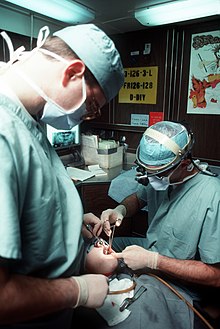
An oral surgeon and dental assistant removing a wisdom tooth
Dentistry, also known as Dental and Oral Medicine, is a branch of medicine that consists of the study, diagnosis, prevention, and treatment of diseases, disorders, and conditions of the oral cavity, commonly in the dentition but also the oral mucosa, and of adjacent and related structures and tissues, particularly in the maxillofacial (jaw and facial) area.[1] Although primarily associated with teeth among the general public, the field of dentistry or dental medicine is not limited to teeth but includes other aspects of the craniofacial complex including the temporomandibular joint and other supporting, muscular, lymphatic, nervous, vascular, and anatomical structures.
Dentistry is often also understood to subsume the now largely defunct medical specialty of stomatology (the study of the mouth and its disorders and diseases) for which reason the two terms are used interchangeably in certain regions.[where?]
Dental treatments are carried out by a dental team, which often consists of a dentist and dental auxiliaries (dental assistants, dental hygienists, dental technicians, as well as dental therapists). Most dentists either work in private practices (primary care), dental hospitals or (secondary care) institutions (prisons, armed forces bases, etc.).
The history of dentistry is almost as ancient as the history of humanity and civilization with the earliest evidence dating from 7000 BC. Remains from the early Harappan periods of the Indus Valley Civilization (c. 3300 BC) show evidence of teeth having been drilled dating back 9,000 years.[2] It is thought that dental surgery was the first specialization from medicine.[3]
Contents
1 Terminology
2 Dental treatment
3 Education and licensing
4 Specialties
5 History
5.1 Modern dentistry
5.2 Hazards in modern dentistry
6 See also
7 Notes
8 References
9 External links
Terminology
The term dentistry comes from dentist, which comes from French dentiste, which comes from the French and Latin words for tooth.[4] The term for the associated scientific study of teeth is odontology (from Ancient Greek ὀδούς (odoús, "tooth")) – the study of the structure, development, and abnormalities of the teeth.
Dental treatment
Dentistry usually encompasses practices related to the oral cavity.[5] According to the World Health Organization, oral diseases are major public health problems due to their high incidence and prevalence across the globe, with the disadvantaged affected more than other socio-economic groups.[6]
The majority of dental treatments are carried out to prevent or treat the two most common oral diseases which are dental caries (tooth decay) and periodontal disease (gum disease or pyorrhea). Common treatments involve the restoration of teeth, extraction or surgical removal of teeth, scaling and root planing and endodontic root canal treatment.
All dentists in the United States undergo at least three years of undergraduate studies, but nearly all complete a bachelor's degree. This schooling is followed by four years of dental school to qualify as a "Doctor of Dental Surgery" (DDS) or "Doctor of Dental Medicine" (DMD). Dentists need to complete additional qualifications or continuing education to carry out more complex treatments such as sedation, oral and maxillofacial surgery, and dental implants.[citation needed]
By nature of their general training they can carry out the majority of dental treatments such as restorative (fillings, crowns, bridges), prosthetic (dentures), endodontic (root canal) therapy, periodontal (gum) therapy, and extraction of teeth, as well as performing examinations, radiographs (x-rays), and diagnosis. Dentists can also prescribe medications such as antibiotics, sedatives, and any other drugs used in patient management.
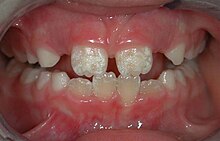
Irreversible enamel defects caused by an untreated celiac disease. They may be the only clue to its diagnosis, even in absence of gastrointestinal symptoms, but are often confused with fluorosis, tetracycline discoloration, or other causes.[7][8][9] The National Institutes of Health include a dental exam in the diagnostic protocol of celiac disease.[7]
Dentists also encourage prevention of oral diseases through proper hygiene and regular, twice yearly, checkups for professional cleaning and evaluation. Oral infections and inflammations may affect overall health and conditions in the oral cavity may be indicative of systemic diseases, such as osteoporosis, diabetes, celiac disease or cancer.[5][7][10][11] Many studies have also shown that gum disease is associated with an increased risk of diabetes, heart disease, and preterm birth. The concept that oral health can affect systemic health and disease is referred to as "oral-systemic health".
Education and licensing
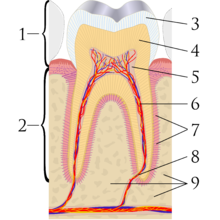
A sagittal cross-section of a molar tooth; 1: crown, 2: root, 3: enamel, 4: dentin and dentin tubules, 5: pulp chamber, 6: blood vessels and nerve, 7: periodontal ligament, 8: apex and periapical region, 9: alveolar bone
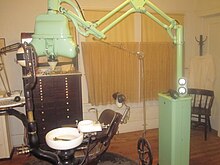
Early dental chair in Pioneer West Museum in Shamrock, Texas
Dr. John M. Harris started the world's first dental school in Bainbridge, Ohio, and helped to establish dentistry as a health profession. It opened on 21 February 1828, and today is a dental museum.[12] The first dental college, Baltimore College of Dental Surgery, opened in Baltimore, Maryland, US in 1840. The second in the United States was the Philadelphia College of Dental Surgery, established in 1852.[13] In 1907, Temple University accepted a bid to incorporate the school.
Studies show that dentists that graduated from different countries,[14] or even from different dental schools in one country,[15] may make different clinical decisions for the same clinical condition. For example, dentists that graduated from Israeli dental schools may recommend the removal of asymptomatic impacted third molar (wisdom teeth) more often than dentists that graduated from Latin American or Eastern European dental schools.[16]
In the United Kingdom, the 1878 British Dentists Act and 1879 Dentists Register limited the title of "dentist" and "dental surgeon" to qualified and registered practitioners.[17][18] However, others could legally describe themselves as "dental experts" or "dental consultants".[19] The practice of dentistry in the United Kingdom became fully regulated with the 1921 Dentists Act, which required the registration of anyone practising dentistry.[20] The British Dental Association, formed in 1880 with Sir John Tomes as president, played a major role in prosecuting dentists practising illegally.[17] Dentists in the United Kingdom are now regulated by the General Dental Council.
In Korea, Taiwan, Japan, Finland, Sweden, Brazil, Chile, the United States, and Canada, a dentist is a healthcare professional qualified to practice dentistry after graduating with a degree of either Doctor of Dental Surgery (DDS) or Doctor of Dental Medicine (DMD). This is equivalent to the Bachelor of Dental Surgery/Baccalaureus Dentalis Chirurgiae (BDS, BDent, BChD, BDSc) that is awarded in the UK and British Commonwealth countries. In most western countries, to become a qualified dentist one must usually complete at least four years of postgraduate study;[21] within the European Union the education has to be at least five years. Dentists usually complete between five and eight years of post-secondary education before practising. Though not mandatory, many dentists choose to complete an internship or residency focusing on specific aspects of dental care after they have received their dental degree.
Specialties
Some dentists undertake further training after their initial degree in order to specialize. Exactly which subjects are recognized by dental registration bodies varies according to location. Examples include:
Dental public health – The study of epidemiology and social health policies relevant to oral health.- Conservative dentistry and endodontics: The art and science of restoring the tooth form and function when destructed by carious and non carious lesions affecting the teeth, before involvement of pulp or root canal is termed as conservative dentistry. When the root canal are involved, the speciality is known as endodontics. This speciality degree is awarded in India.
Endodontics (also called endodontology) – Root canal therapy and study of diseases of the dental pulp and periapical tissues.
Forensic odontology – The gathering and use of dental evidence in law. This may be performed by any dentist with experience or training in this field. The function of the forensic dentist is primarily documentation and verification of identity.
Geriatric dentistry or Geriodontics – The delivery of dental care to older adults involving the diagnosis, prevention, and treatment of problems associated with normal aging and age-related diseases as part of an interdisciplinary team with other health care professionals.
Oral and maxillofacial pathology – The study, diagnosis, and sometimes the treatment of oral and maxillofacial related diseases.
Oral and maxillofacial radiology – The study and radiologic interpretation of oral and maxillofacial diseases.
Oral and maxillofacial surgery (also called oral surgery) – Extractions, implants, and surgery of the jaws, mouth and face.[nb 1]
Oral biology – Research in dental and craniofacial biology
Oral Implantology – The art and science of replacing extracted teeth with dental implants.
Oral medicine – The clinical evaluation and diagnosis of oral mucosal diseases
Orthodontics and dentofacial orthopedics – The straightening of teeth and modification of midface and mandibular growth.
Pediatric dentistry (also called pedodontics) – Dentistry for children
Periodontology (also called periodontics) – The study and treatment of diseases of the periodontium (non-surgical and surgical) as well as placement and maintenance of dental implants
Prosthodontics (also called prosthetic dentistry) – Dentures, bridges and the restoration of implants. Some prosthodontists further their training in "oral and maxillofacial prosthodontics", which is the discipline concerned with the replacement of missing facial structures, such as ears, eyes, noses, etc.
Special needs dentistry (also called special care dentistry) – Dentistry for those with developmental and acquired disabilities.
Veterinary dentistry, a speciality of veterinary medicine – The field of dentistry applied to the care of animals.[22][23]
History
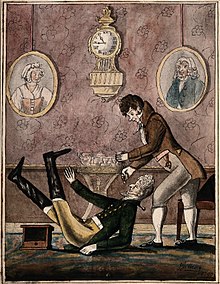
"A wealthy patient falling over because of having a tooth extracted with such vigour by a fashionable dentist", c. 1790.
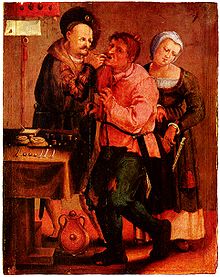
Farmer at the dentist, Johann Liss, c. 1616–17
Tooth decay was low in pre-agricultural societies, the growth in farming society about 10,000 years ago correlated with an increase in tooth decay (cavities).[24] An infected tooth from Italy partially cleaned with flint tools, between 13,820 and 14,160 years old, represents the oldest known dentistry,[25] although a 2017 study suggests that 130,000 years ago the Neanderthals already used rudimentary dentistry tools.[26] The Indus Valley Civilization (IVC) has yielded evidence of dentistry being practised as far back as 7000 BC.[27] An IVC site in Mehrgarh indicates that this form of dentistry involved curing tooth related disorders with bow drills operated, perhaps, by skilled bead crafters.[2] The reconstruction of this ancient form of dentistry showed that the methods used were reliable and effective.[28] The earliest dental filling, made of beeswax, was discovered in Slovenia and dates from 6500 years ago.[29] Dentistry was practiced in prehistoric Malta, as evidenced by a skull which had an abscess lanced from the root of a tooth dating back to around 2500 BC.[30]
An ancient Sumerian text describes a "tooth worm" as the cause of dental caries.[31] Evidence of this belief has also been found in ancient India, Egypt, Japan, and China. The legend of the worm is also found in the writings of Homer[where?], and as late as the 14th century AD the surgeon Guy de Chauliac still promoted the belief that worms cause tooth decay.[32]
Recipes for the treatment of toothache, infections and loose teeth are spread throughout the Ebers Papyrus, Kahun Papyri, Brugsch Papyrus, and Hearst papyrus of Ancient Egypt.[33] The Edwin Smith Papyrus, written in the 17th century BC but which may reflect previous manuscripts from as early as 3000 BC, discusses the treatment of dislocated or fractured jaws.[33][34] In the 18th century BC, the Code of Hammurabi referenced dental extraction twice as it related to punishment.[35] Examination of the remains of some ancient Egyptians and Greco-Romans reveals early attempts at dental prosthetics.[36] However, it is possible the prosthetics were prepared after death for aesthetic reasons.[33]
Ancient Greek scholars Hippocrates and Aristotle wrote about dentistry, including the eruption pattern of teeth, treating decayed teeth and gum disease, extracting teeth with forceps, and using wires to stabilize loose teeth and fractured jaws.[37] Some say the first use of dental appliances or bridges comes from the Etruscans from as early as 700 BC.[38] In ancient Egypt, Hesy-Ra is the first named "dentist" (greatest of the teeth). The Egyptians bound replacement teeth together with gold wire. Roman medical writer Cornelius Celsus wrote extensively of oral diseases as well as dental treatments such as narcotic-containing emollients and astringents.[39][40] The earliest dental amalgams were first documented in a Tang Dynasty medical text written by the Chinese physician Su Kung in 659, and appeared in Germany in 1528.[41][42]
During the Islamic Golden Age Dentistry was discussed in several famous books of medicine such as The Canon in medicine written by Avicenna and Al-Tasreef by Al-Zahrawi who is considered the greatest surgeon of the Middle ages,[43] Avicenna said that jaw fracture should be reduced according to the occlusal guidance of the teeth; this principle is still valid in modern times. while Al-Zahrawi made a lot of surgical tools that resemble the modern tools.
Historically, dental extractions have been used to treat a variety of illnesses. During the Middle Ages and throughout the 19th century, dentistry was not a profession in itself, and often dental procedures were performed by barbers or general physicians. Barbers usually limited their practice to extracting teeth which alleviated pain and associated chronic tooth infection. Instruments used for dental extractions date back several centuries. In the 14th century, Guy de Chauliac most probably invented the dental pelican[44] (resembling a pelican's beak) which was used to perform dental extractions up until the late 18th century. The pelican was replaced by the dental key[45] which, in turn, was replaced by modern forceps in the 19th century.[46]

Dental needle-nose pliers designed by Fauchard in the late 17th century to use in prosthodontics
The first book focused solely on dentistry was the "Artzney Buchlein" in 1530,[37] and the first dental textbook written in English was called "Operator for the Teeth" by Charles Allen in 1685.[18]
In the United Kingdom there was no formal qualification for the providers of dental treatment until 1859 and it was only in 1921 that the practice of dentistry was limited to those who were professionally qualified. The Royal Commission on the National Health Service in 1979 reported that there were then more than twice as many registered dentists per 10,000 population in the UK than there were in 1921.[47]
Modern dentistry
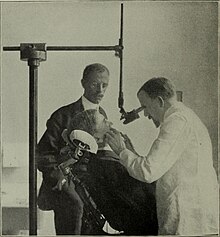
A microscopic device used in dental analysis, c. 1900
It was between 1650 and 1800 that the science of modern dentistry developed. The English physician Thomas Browne in his A Letter to a Friend (c. 1656 pub. 1690) made an early dental observation with characteristic humour:
.mw-parser-output .templatequoteoverflow:hidden;margin:1em 0;padding:0 40px.mw-parser-output .templatequote .templatequoteciteline-height:1.5em;text-align:left;padding-left:1.6em;margin-top:0
The Egyptian Mummies that I have seen, have had their Mouths open, and somewhat gaping, which affordeth a good opportunity to view and observe their Teeth, wherein 'tis not easie to find any wanting or decayed: and therefore in Egypt, where one Man practised but one Operation, or the Diseases but of single Parts, it must needs be a barren Profession to confine unto that of drawing of Teeth, and little better than to have been Tooth-drawer unto King Pyrrhus, who had but two in his Head.
The French surgeon Pierre Fauchard became known as the "father of modern dentistry". Despite the limitations of the primitive surgical instruments during the late 17th and early 18th century, Fauchard was a highly skilled surgeon who made remarkable improvisations of dental instruments, often adapting tools from watchmakers, jewelers and even barbers, that he thought could be used in dentistry. He introduced dental fillings as treatment for dental cavities. He asserted that sugar derivate acids like tartaric acid were responsible for dental decay, and also suggested that tumors surrounding the teeth and in the gums could appear in the later stages of tooth decay.[48][49]

Panoramic radiograph of historic dental implants, made 1978
Fauchard was the pioneer of dental prosthesis, and he discovered many methods to replace lost teeth. He suggested that substitutes could be made from carved blocks of ivory or bone. He also introduced dental braces, although they were initially made of gold, he discovered that the teeth position could be corrected as the teeth would follow the pattern of the wires. Waxed linen or silk threads were usually employed to fasten the braces. His contributions to the world of dental science consist primarily of his 1728 publication Le chirurgien dentiste or The Surgeon Dentist. The French text included "basic oral anatomy and function, dental construction, and various operative and restorative techniques, and effectively separated dentistry from the wider category of surgery".[48][49]

A modern Dentist's chair
After Fauchard, the study of dentistry rapidly expanded. Two important books, Natural History of Human Teeth (1771) and Practical Treatise on the Diseases of the Teeth (1778), were published by British surgeon John Hunter. In 1763 he entered into a period of collaboration with the London-based dentist James Spence. He began to theorise about the possibility of tooth transplants from one person to another. He realised that the chances of an (initially, at least) successful tooth transplant would be improved if the donor tooth was as fresh as possible and was matched for size with the recipient. These principles are still used in the transplantation of internal organs. Hunter conducted a series of pioneering operations, in which he attempted a tooth transplant. Although the donated teeth never properly bonded with the recipients' gums, one of Hunter's patients stated that he had three which lasted for six years, a remarkable achievement for the period.[50]
Major advances were made in the 19th century, and dentistry evolved from a trade to a profession. The profession came under government regulation by the end of the 19th century. In the UK the Dentist Act was passed in 1878 and the British Dental Association formed in 1879. In the same year, Francis Brodie Imlach was the first ever dentist to be elected President of the Royal College of Surgeons (Edinburgh), raising dentistry onto a par with clinical surgery for the first time.[51]
Hazards in modern dentistry
Long term occupational noise exposure can contribute to permanent hearing loss, which is referred to as noise-induced hearing loss (NIHL) and tinnitus. Noise exposure can cause excessive stimulation of the hearing mechanism, which damages the delicate structures of the inner ear.[52] NIHL can occur when an individual is exposed to sound levels above 90 dBA according to the Occupational Safety and Health Administration (OSHA). Regulations state that the permissible noise exposure levels for individuals is 90 dBA.[53] For the National Institute for Occupational Safety and Health (NIOSH), exposure limits are set to 85 dBA. Exposures below 85 dBA are not considered to be hazardous. Time limits are placed on how long an individual can stay in an environment above 85 dBA before it causes hearing loss. OSHA places that limitation at 8 hours for 85 dBA. The exposure time becomes shorter as the dBA level increases.
Within the field of dentistry, a variety of cleaning tools are used including piezoelectric and sonic scalers, and ultrasonic scalers and cleaners.[54] While a majority of the tools do not exceed 75 dBA,[55] prolonged exposure over many years can lead to hearing loss or complaints of tinnitus.[56] Few dentists have reported using personal hearing protective devices,[57][58] which could offset any potential hearing loss or tinnitus.
See also
- List of dental organizations
Notes
^ The scope of Oral and maxillofacial surgery is variable. In some countries, both a medical and dental degree is required for training, and the scope includes head and neck oncology and craniofacial deformity.
References
^ "Glossary of Dental Clinical and Administrative Terms". American Dental Association. Retrieved 1 February 2014..mw-parser-output cite.citationfont-style:inherit.mw-parser-output qquotes:"""""""'""'".mw-parser-output code.cs1-codecolor:inherit;background:inherit;border:inherit;padding:inherit.mw-parser-output .cs1-lock-free abackground:url("//upload.wikimedia.org/wikipedia/commons/thumb/6/65/Lock-green.svg/9px-Lock-green.svg.png")no-repeat;background-position:right .1em center.mw-parser-output .cs1-lock-limited a,.mw-parser-output .cs1-lock-registration abackground:url("//upload.wikimedia.org/wikipedia/commons/thumb/d/d6/Lock-gray-alt-2.svg/9px-Lock-gray-alt-2.svg.png")no-repeat;background-position:right .1em center.mw-parser-output .cs1-lock-subscription abackground:url("//upload.wikimedia.org/wikipedia/commons/thumb/a/aa/Lock-red-alt-2.svg/9px-Lock-red-alt-2.svg.png")no-repeat;background-position:right .1em center.mw-parser-output .cs1-subscription,.mw-parser-output .cs1-registrationcolor:#555.mw-parser-output .cs1-subscription span,.mw-parser-output .cs1-registration spanborder-bottom:1px dotted;cursor:help.mw-parser-output .cs1-hidden-errordisplay:none;font-size:100%.mw-parser-output .cs1-visible-errorfont-size:100%.mw-parser-output .cs1-subscription,.mw-parser-output .cs1-registration,.mw-parser-output .cs1-formatfont-size:95%.mw-parser-output .cs1-kern-left,.mw-parser-output .cs1-kern-wl-leftpadding-left:0.2em.mw-parser-output .cs1-kern-right,.mw-parser-output .cs1-kern-wl-rightpadding-right:0.2em
^ ab "Stone age man used dentist drill". BBC News. 6 April 2006. Retrieved 24 May 2010.
^ Suddick, RP; Harris, NO (1990). "Historical perspectives of oral biology: a series". Critical Reviews in Oral Biology and Medicine. 1 (2): 135–51. doi:10.1177/10454411900010020301. PMID 2129621.
^ "dentistry". Etymonline.com. Retrieved 17 May 2018.
^ ab Gambhir RS (2015). "Primary care in dentistry – an untapped potential". J Family Med Prim Care (Review). 4 (1): 13–18. doi:10.4103/2249-4863.152239. PMC 4366984. PMID 25810982.
^ "What is the burden of oral disease?". WHO. Retrieved 6 June 2017.
^ abc "Diagnosis of Celiac Disease". National Institute of Health (NIH). Archived from the original on 15 May 2017. Retrieved 6 June 2017.CS1 maint: BOT: original-url status unknown (link)
^ Dental Enamel Defects and Celiac Disease Archived March 5, 2016, at the Wayback Machine. National Institute of Health (NIH)
^ Pastore L, Carroccio A, Compilato D, Panzarella V, Serpico R, Lo Muzio L (2008). "Oral manifestations of celiac disease". J Clin Gastroenterol (Review). 42 (3): 224–32. doi:10.1097/MCG.0b013e318074dd98. hdl:10447/1671. PMID 18223505.
^ Estrella MR, Boynton JR (2010). "General dentistry's role in the care for children with special needs: a review". Gen Dent (Review). 58 (3): 222–29. PMID 20478802.
^ da Fonseca MA (2010). "Dental and oral care for chronically ill children and adolescents". Gen Dent (Review). 58 (3): 204–09, quiz 210–11. PMID 20478800.
^ Owen, Lorrie K., ed. Dictionary of Ohio Historic Places. Vol. 2. St. Clair Shores: Somerset, 1999, 1217–1218.
^ "History". Pennsylvania School of Dental Medicine. Retrieved 13 January 2016.
^ Zadik Yehuda; Levin Liran (January 2008). "Clinical decision making in restorative dentistry, endodontics, and antibiotic prescription". J Dent Educ. 72 (1): 81–86. PMID 18172239.
^ Zadik Yehuda; Levin Liran (April 2006). "Decision making of Hebrew University and Tel Aviv University Dental Schools graduates in every day dentistry—is there a difference?". J Isr Dent Assoc. 23 (2): 19–23. PMID 16886872.
^ Zadik Yehuda; Levin Liran (April 2007). "Decision making of Israeli, East European, and South American dental school graduates in third molar surgery: is there a difference?". J Oral Maxillofac Surg. 65 (4): 658–62. doi:10.1016/j.joms.2006.09.002. PMID 17368360. Retrieved 16 July 2008.
^ ab Gelbier, Stanley. 125 Years of Developments in Dentistry. British Dental Journal (2005); 199, 470–73. The 1879 register is referred to as the "Dental Register".
^ ab The story of dentistry: Dental History Timeline Archived 9 March 2012 at the Wayback Machine., hosted on the British Dental Association website. Page accessed 2 March 2010.
^ J Menzies Campbell (8 February 1955). "Banning Clerks, Colliers and other Charlatans". The Glasgow Herald. p. 3. Retrieved 5 April 2017.
^ History of Dental Surgery in Edinburgh (PDF), hosted on the Royal College of Surgeons of Edinburgh website. Page accessed 11 December 2007.
^ "Dentistry (D.D.S. or D.M.D.)" (PDF). Purdue.edu. Retrieved 17 May 2018.
^ "AVDC Home". Avdc.org. 29 November 2009. Retrieved 18 April 2010.
^ "EVDC web site". Evdc.info. Retrieved 18 April 2010.
^ Barras, Colin (29 February 2016). "How our ancestors drilled rotten teeth". BBC. Retrieved 1 March 2016.
^ "Oldest Dentistry Found in 14,000-Year-Old Tooth". Discovery Channel. 16 July 2015. Retrieved 21 July 2015.
^ "Analysis of Neanderthal teeth marks uncovers evidence of prehistoric dentistry". The University of Kansas. 28 June 2017. Retrieved 1 July 2017.
^ Coppa, A. et al. 2006. "Early Neolithic tradition of dentistry" (PDF). Nature. Volume 440. 6 April 2006.
^ MSNBC (2008). Dig uncovers ancient roots of dentistry.
^ Bernardini, Federico; Tuniz, Claudio; Coppa, Alfredo; Mancini, Lucia; Dreossi, Diego; Eichert, Diane; Turco, Gianluca; Biasotto, Matteo; Terrasi, Filippo; De Cesare, Nicola; Hua, Quan; Levchenko, Vladimir (2012). "Beeswax as Dental Filling on a Neolithic Human Tooth". PLoS ONE. 7 (9): e44904. doi:10.1371/journal.pone.0044904. PMC 3446997. PMID 23028670.
^ "700 years added to Malta's history". Times of Malta. 16 March 2018. Archived from the original on 16 March 2018.
^ "History of Dentistry: Ancient Origins". American Dental Association. Archived from the original on 16 July 2007. Retrieved 9 January 2007.
^ Suddick Richard P., Harris Norman O. (1990). "Historical Perspectives of Oral Biology: A Series" (PDF). Critical Reviews in Oral Biology and Medicine. 1 (2): 135–51. Archived from the original (PDF) on 18 December 2007.
^ abc Blomstedt, P. (2013). "Dental surgery in ancient Egypt". Journal of the History of Dentistry. 61 (3): 129–42. PMID 24665522.
^ Ancient Egyptian Dentistry, hosted on the University of Oklahoma website. Page accessed 15 December 2007. Version archived by the Wayback Machine on 26 December 2007.
^ Wilwerding, Terry. "History of Dentistry 2001" (PDF). Retrieved 3 November 2014.
^ "Medicine in Ancient Egypt 3". Arabworldbooks.com. Retrieved 18 April 2010.
^ ab "History Of Dentistry". Complete Dental Guide. Archived from the original on 14 July 2016. Retrieved 29 June 2016.
^ "History of Dentistry Research Page, Newsletter". Rcpsg.ac.uk. Retrieved 9 June 2014.
^ "Dentistry – Skill And Superstition". Science.jrank.org. Retrieved 18 April 2010.
^ "Dental Treatment in the Ancient Times". Dentaltreatment.org.uk. Archived from the original on 1 December 2009. Retrieved 18 April 2010.
^ Bjørklund G (1989). "The history of dental amalgam (in Norwegian)". Tidsskr nor Laegeforen. 109 (34–36): 3582–85. PMID 2694433.
^ Czarnetzki, A.; Ehrhardt S. (1990). "Re-dating the Chinese amalgam-filling of teeth in Europe". International Journal of Anthropology. 5 (4): 325–32.
^ Meri, Josef (2005). Medieval Islamic Civilization: An Encyclopedia (Routledge Encyclopedias of the Middle Ages). Psychology Press. ISBN 978-0415966900.
^ Gregory Ribitzky. "Pelican". Retrieved 23 June 2018.
^ Gregory Ribitzky. "Toothkey". Retrieved 23 June 2018.
^ Gregory Ribitzky. "Forceps". Retrieved 23 June 2018.
^ Royal Commission on the NHS Chapter 9. HMSO. July 1979. ISBN 978-0101761505. Retrieved 19 May 2015.
^ ab André Besombes; Phillipe de Gaillande (1993). Pierre Fauchard (1678–1761): The First Dental Surgeon, His Work, His Actuality. Pierre Fauchard Academy.
^ ab Bernhard Wolf Weinberger (1941). Pierre Fauchard, Surgeon-dentist: A Brief Account of the Beginning of Modern Dentistry, the First Dental Textbook, and Professional Life Two Hundred Years Ago. Pierre Fauchard Academy.
^ Moore, Wendy (30 September 2010). The Knife Man. Transworld. pp. 223–24. ISBN 978-1409044628. Retrieved 8 March 2012.
^ Dingwall, Helen (April 2004). "A pioneering history: dentistry and the Royal College of Surgeons of Edinburgh" (PDF). History of Dentistry Newsletter (14). Archived from the original (PDF) on 1 February 2013.
^ "Noise-Induced Hearing Loss". NIDCD. 18 August 2015.
^ "Occupational Safety and Health Standards | Occupational Safety and Health Administration". Osha.gov.
^ Stevens, M (1999). "Is someone listening to the din of occupational noise exposure in dentistry". RDH (19): 34–85.
^ Merrel, HB (1992). "Noise pollution and hearing loss in the dental office". Dental Assisting Journal. 61 (3): 6–9.
^ Wilson, J.D. (2002). "Effects of occupational ultrasonic noise exposure on hearing of dental hygienists: A pilot study". Journal of Dental Hygiene. 76 (4): 262–69.
^ Leggat, P.A. (2007). "Occupational Health Problems in Modern Dentistry: A Review". Industrial Health. 45 (5): 611–21. doi:10.2486/indhealth.45.611.
^ Leggat, P.A. (2001). "Occupational hygiene practices of dentists in southern Thailand". International Dentistry Journal (51).
External links
| Wikiversity has learning resources about School:Dentistry |
| Look up dentistry in Wiktionary, the free dictionary. |
| Wikimedia Commons has media related to Dentistry. |
| Wikiquote has quotations related to: Dentistry |
Dentistry at Curlie
